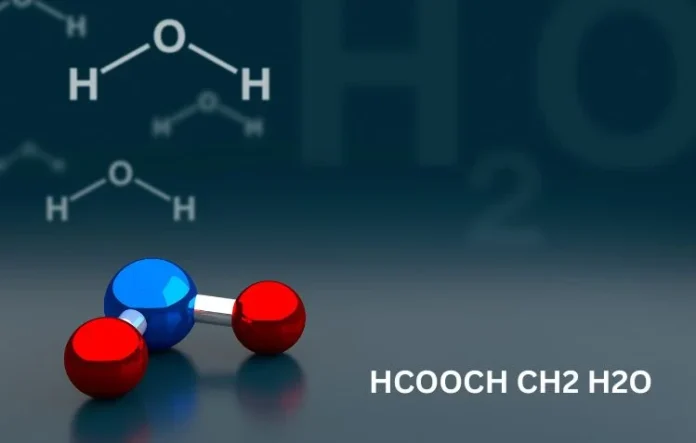Introduction to HCOOCH (CH2) H2O
HCOOCH (CH2) H2O is a chemical compound that combines various functional groups commonly found in organic chemistry. It consists of an ester group (HCOO), a methylene group (CH2), and a hydroxyl group (H2O), all of which contribute to its unique properties and potential applications. This compound is a part of a broader class of molecules, including esters and alcohols, which play significant roles in industries such as pharmaceuticals, agriculture, and materials science. Understanding the molecular structure and properties of HCOOCH (CH2) H2O is key to grasping its behavior in chemical reactions, its uses in synthetic chemistry, and its role in various industrial processes. This article will explore the structure, properties, and potential applications of HCOOCH (CH2) H2O, shedding light on its significance in both theoretical and practical chemistry.
Chemical Structure and Composition
The molecular structure of HCOOCH (CH2) H2O reveals its composition of carbon (C), hydrogen (H), and oxygen (O) atoms arranged into specific functional groups. The compound consists of an ester group, -COOCH2-, which is formed by the reaction of a carboxylic acid (HCOOH) and an alcohol (CH3OH). The presence of the methylene group (-CH2-) in the middle of the structure introduces additional flexibility to the compound’s properties, allowing it to participate in various reactions. Lastly, the inclusion of a hydroxyl group (OH) at the end of the molecule makes it resemble alcohols and contributes to its ability to form hydrogen bonds, which can influence its solubility, reactivity, and boiling point. These components collectively make HCOOCH (CH2) H2O a versatile compound that can be utilized in different chemical syntheses and industrial applications.
Properties and Characteristics
HCOOCH (CH2) H2O exhibits several distinct properties that make it useful in both laboratory and industrial settings. Due to the ester functional group, this compound may possess moderate solubility in polar solvents such as water or alcohols, though its solubility can vary depending on the specific structure and environmental factors. The hydroxyl group allows the compound to participate in hydrogen bonding, which can influence its interaction with other molecules, especially in biological systems. The compound’s molecular weight, boiling point, and melting point are influenced by the interactions between the ester and hydroxyl groups, making it an ideal candidate for studies in physical chemistry. Additionally, HCOOCH (CH2) H2O’s reactivity can be fine-tuned in synthetic chemistry, allowing it to undergo various transformations, including ester hydrolysis, oxidation, or condensation reactions. These versatile properties make it an important compound for further exploration in both academic research and industrial applications.
Synthesis and Chemical Reactions
The synthesis of HCOOCH (CH2) H2O typically involves a reaction between a carboxylic acid (HCOOH) and an alcohol (CH3OH), a process known as esterification. This reaction is catalyzed by an acid catalyst, often sulfuric acid, to drive the formation of the ester linkage while eliminating water as a byproduct. The methylene group (-CH2-) introduces an additional level of complexity, as it can participate in various reactions, including nucleophilic substitutions or eliminations, which make it a useful building block for more complex molecules. HCOOCH (CH2) H2O’s ester bond is particularly reactive under acidic or basic conditions, and it can undergo hydrolysis, breaking down into its constituent carboxylic acid and alcohol when exposed to water and an appropriate catalyst. This ability to participate in hydrolysis reactions makes HCOOCH (CH2) H2O useful in applications where selective breakdown or modification of esters is necessary.
Applications in Industry and Research
In industrial applications, HCOOCH (CH2) H2O plays an essential role in the synthesis of various chemicals, including plasticizers, solvents, and pharmaceuticals. Due to its ester functionality, it can be incorporated into polymerization reactions to create flexible and durable materials used in packaging, coatings, and other consumer goods. Additionally, the compound’s hydroxyl group enhances its solubility in water-based solutions, making it a potential candidate for use in agricultural formulations, where solubility and bioavailability are key considerations. In research, HCOOCH (CH2) H2O is often employed as a reagent in organic synthesis, where its ester group can be modified or exchanged to create more complex molecules with desired functionalities. The versatility of this compound makes it a valuable tool in synthetic chemistry, particularly in the design of novel compounds for drug development and other specialized chemical products.
Environmental Impact and Safety Considerations
As with many chemicals used in industrial applications, it is essential to consider the environmental impact and safety considerations of HCOOCH (CH2) H2O. While the compound is not typically classified as highly toxic, proper handling and disposal methods should be followed to avoid potential environmental harm. The ester functional group can undergo hydrolysis, potentially releasing harmful byproducts into the environment if not properly managed. Safety measures should include using protective equipment such as gloves and goggles during synthesis or manipulation of the compound, as well as ensuring proper ventilation in laboratory settings. Additionally, because HCOOCH (CH2) H2O is used in various consumer products, its long-term environmental effects should be studied to ensure its sustainability in large-scale applications.
Conclusion: The Importance of HCOOCH (CH2) H2O in Chemistry and Industry
In summary, HCOOCH (CH2) H2O is a versatile and essential compound in both academic and industrial chemistry. Its unique molecular structure, combining ester and hydroxyl functionalities, makes it a useful building block in organic synthesis, while its physical properties allow it to participate in a range of chemical reactions. From the synthesis of complex molecules to applications in pharmaceuticals and industrial processes, HCOOCH (CH2) H2O plays a significant role in advancing chemical science and improving products across various industries. Understanding its properties, reactivity, and potential applications helps researchers and engineers harness its full potential, ensuring its continued relevance in modern chemistry and industrial practices.


